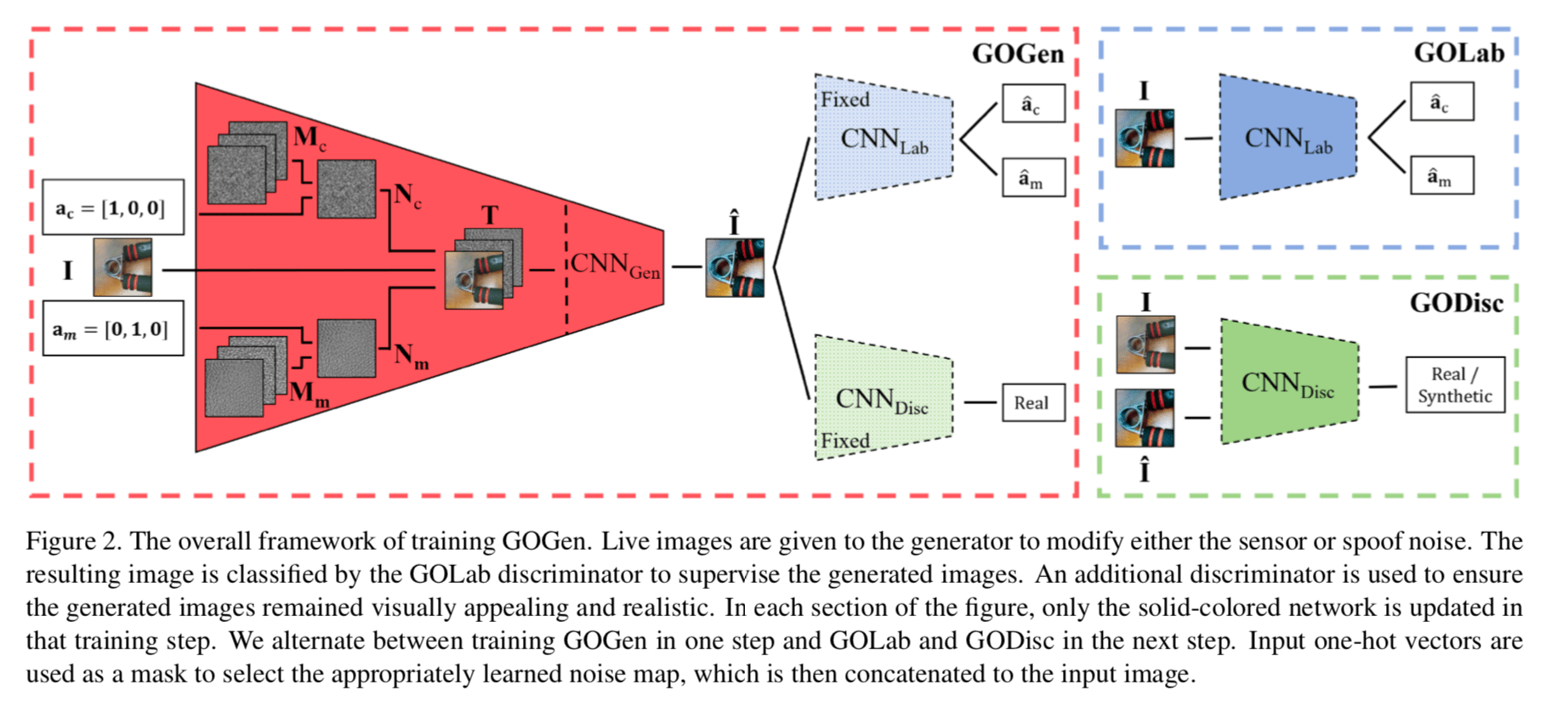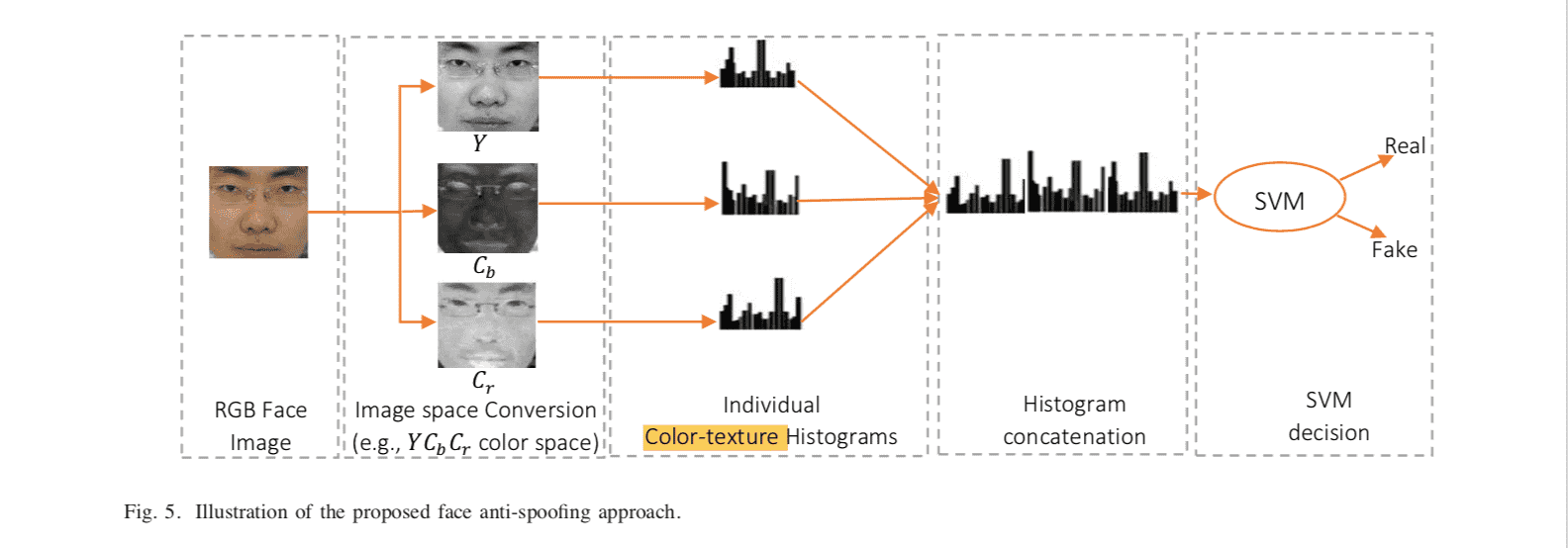人脸活体检测综述
基本思路:
- 传统方法: 线索->构造特征
- 深度方法: 线索->构造算子/网路
论文
- Deep Spatial Gradient and Temporal Depth Learning for Face Anti-spoofing1
- Searching Central Difference Convolutional Networks for Face Anti-Spoofing2
- Noise Modeling, Synthesis and Classification for Generic Object Anti-Spoofing3

- Learning Meta Model for Zero- and Few-shot Face Anti-spoofing4
-
[2019] Deep Tree Learning for Zero-shot Face Anti-Spoofing5
- [2019] Learning Meta Model for Zero- and Few-shot Face Anti-spoofing4
文章认为, 当下把活体检测采用监督学习方法, 容易过拟合已知的攻击形式, 对于未知的攻击方式泛华能力较差. 提出两点改进思路:- 学习可分的特征, 而非直接分类. 并且要求特征对于未见过的攻击手段仍具有较好的区分度
- 迅速通过少量的新的攻击样本习得检测区分能力
攻击形式:
- 打印
- 屏幕照片(screen)
- 雕塑模型
- 面具
方法
-
成像的物理过程差异, 构造可分特征
(1) specular reflection from the printed paper surface or LCD screen; (2) image blurriness due to camera defocus; (3) image chromaticity and contrast distortion due to imperfect color rendering of printer or LCD screen; and (4) color diversity distortion due to limited color resolution of printer or LCD screen. 6
The camera used for capturing the targeted face sample will also lead to imperfect colour reproduction compared to the legitimate sample. Furthermore, a recaptured face image is likely to contain local and overall variations of colour due to other imperfections in the reproduction process of the targeted face 7

参考资料
- Awesome-FAS (Face Anti-Spoofing)
- 活体检测Face Anti-spoofing综述Fisher Yu余梓彤
- 知乎汇总
- Face Anti-spoofing Attack Detection Challenge@CVPR2020
- Anti-spoofing for face recognition
- https://github.com/JinghuiZhou/awesome_face_antispoofing
- https://github.com/ee09115/spoofing_detection
- https://www.pyimagesearch.com/2019/03/11/liveness-detection-with-opencv/
- CVPR & AAAI 2020 人脸活体检测最新进展
- 基于rPPG的人脸活体检测综述
- https://github.com/ZitongYu/CDCN
- What is a Presentation Attack? And how do we detect it?
- CVPR2019 人脸活体检测专题
参考文献
-
Z. Wang et al., “Deep Spatial Gradient and Temporal Depth Learning for Face Anti-spoofing,” arXiv:2003.08061 [cs], Mar. 2020, Accessed: Apr. 07, 2020. [Online]. Available: http://arxiv.org/abs/2003.08061. ↩
-
Z. Yu et al., “Searching Central Difference Convolutional Networks for Face Anti-Spoofing,” arXiv:2003.04092 [cs], Mar. 2020, Accessed: Apr. 06, 2020. [Online]. Available: http://arxiv.org/abs/2003.04092. ↩
-
J. Stehouwer, A. Jourabloo, Y. Liu, and X. Liu, “Noise Modeling, Synthesis and Classification for Generic Object Anti-Spoofing,” arXiv:2003.13043 [cs, eess], Mar. 2020, Accessed: Apr. 09, 2020. [Online]. Available: http://arxiv.org/abs/2003.13043. ↩
-
Y. Qin et al., “Learning Meta Model for Zero- and Few-shot Face Anti-spoofing,” arXiv:1904.12490 [cs], Dec. 2019, Accessed: Apr. 08, 2020. [Online]. Available: http://arxiv.org/abs/1904.12490. ↩ ↩2
-
Y. Liu, J. Stehouwer, A. Jourabloo, and X. Liu, “Deep Tree Learning for Zero-shot Face Anti-Spoofing,” arXiv:1904.02860 [cs], Apr. 2019, Accessed: Apr. 04, 2020. [Online]. Available: http://arxiv.org/abs/1904.02860. ↩
-
D. Wen, H. Han, and A. K. Jain, “Face Spoof Detection With Image Distortion Analysis,” IEEE Transactions on Information Forensics and Security, vol. 10, no. 4, pp. 746–761, Apr. 2015, doi: 10.1109/TIFS.2015.2400395. ↩
-
Z. Boulkenafet, J. Komulainen, and A. Hadid, “Face Spoofing Detection Using Colour Texture Analysis,” IEEE Transactions on Information Forensics and Security, vol. 11, pp. 1–1, Aug. 2016, doi: 10.1109/TIFS.2016.2555286. ↩